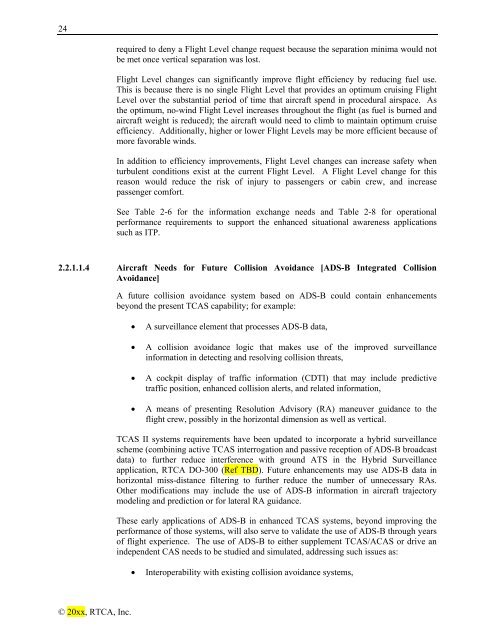Minimum Aviation System Performance Standards for Aircraft ...
Minimum Aviation System Performance Standards for Aircraft ...
Minimum Aviation System Performance Standards for Aircraft ...
You also want an ePaper? Increase the reach of your titles
YUMPU automatically turns print PDFs into web optimized ePapers that Google loves.
24<br />
required to deny a Flight Level change request because the separation minima would not<br />
be met once vertical separation was lost.<br />
Flight Level changes can significantly improve flight efficiency by reducing fuel use.<br />
This is because there is no single Flight Level that provides an optimum cruising Flight<br />
Level over the substantial period of time that aircraft spend in procedural airspace. As<br />
the optimum, no-wind Flight Level increases throughout the flight (as fuel is burned and<br />
aircraft weight is reduced); the aircraft would need to climb to maintain optimum cruise<br />
efficiency. Additionally, higher or lower Flight Levels may be more efficient because of<br />
more favorable winds.<br />
In addition to efficiency improvements, Flight Level changes can increase safety when<br />
turbulent conditions exist at the current Flight Level. A Flight Level change <strong>for</strong> this<br />
reason would reduce the risk of injury to passengers or cabin crew, and increase<br />
passenger com<strong>for</strong>t.<br />
See Table 2-6 <strong>for</strong> the in<strong>for</strong>mation exchange needs and Table 2-8 <strong>for</strong> operational<br />
per<strong>for</strong>mance requirements to support the enhanced situational awareness applications<br />
such as ITP.<br />
2.2.1.1.4 <strong>Aircraft</strong> Needs <strong>for</strong> Future Collision Avoidance [ADS-B Integrated Collision<br />
Avoidance]<br />
© 20xx, RTCA, Inc.<br />
A future collision avoidance system based on ADS-B could contain enhancements<br />
beyond the present TCAS capability; <strong>for</strong> example:<br />
� A surveillance element that processes ADS-B data,<br />
� A collision avoidance logic that makes use of the improved surveillance<br />
in<strong>for</strong>mation in detecting and resolving collision threats,<br />
� A cockpit display of traffic in<strong>for</strong>mation (CDTI) that may include predictive<br />
traffic position, enhanced collision alerts, and related in<strong>for</strong>mation,<br />
� A means of presenting Resolution Advisory (RA) maneuver guidance to the<br />
flight crew, possibly in the horizontal dimension as well as vertical.<br />
TCAS II systems requirements have been updated to incorporate a hybrid surveillance<br />
scheme (combining active TCAS interrogation and passive reception of ADS-B broadcast<br />
data) to further reduce interference with ground ATS in the Hybrid Surveillance<br />
application, RTCA DO-300 (Ref TBD). Future enhancements may use ADS-B data in<br />
horizontal miss-distance filtering to further reduce the number of unnecessary RAs.<br />
Other modifications may include the use of ADS-B in<strong>for</strong>mation in aircraft trajectory<br />
modeling and prediction or <strong>for</strong> lateral RA guidance.<br />
These early applications of ADS-B in enhanced TCAS systems, beyond improving the<br />
per<strong>for</strong>mance of those systems, will also serve to validate the use of ADS-B through years<br />
of flight experience. The use of ADS-B to either supplement TCAS/ACAS or drive an<br />
independent CAS needs to be studied and simulated, addressing such issues as:<br />
� Interoperability with existing collision avoidance systems,

















